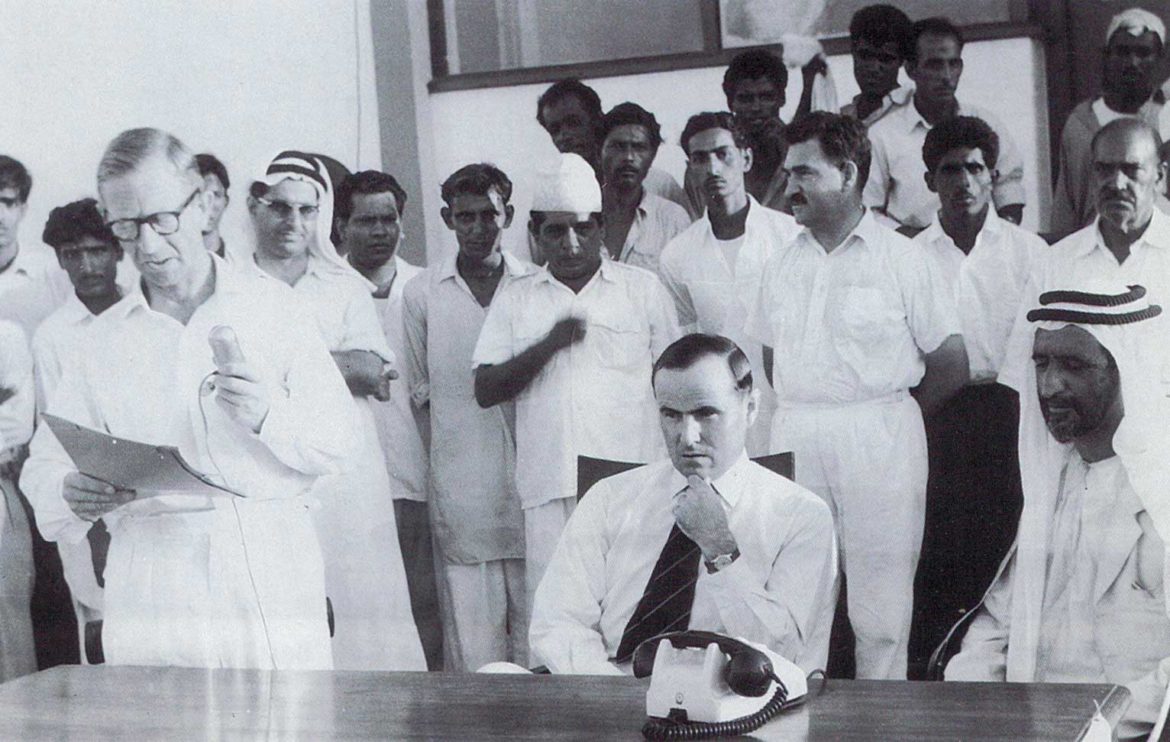Sixty years ago today, someone places a telephone on a table. Seated and centered is Donald Hawley. Always comfortable at the head of a table, Hawley serves as the political agent, the highest-ranking British official in town. Dubai is still one of the Trucial States beholden to truces written by British power. The man to Hawley’s left is Sheikh Rashid bin Saeed Al Maktoum, less at ease in his seat and with ceremony in general. He has ruled Dubai for less than two years. The man standing to Hawley’s right is Mr. Laws, or maybe Mr. Wright, of International Aeradio Ltd—IAL for short. He reads remarks into a microphone attached to the wire that reaches upward in the background, trails the edge of the new building IAL has built, and finally connects to loudspeakers mounted on the building’s eaves.
Behind these men are more men, mostly from South Asia, who listen to Mr. Laws’s broadcasted words. They are the quiet observers—taking pause from constructing new buildings, catering festive meals like the one soon to start, and digging the trenches into Dubai’s swampy sands to lay the copper wiring that eventually reaches back up out of the ground toward that wooden table and gets inserted into the telephone—the device which brings everyone together on July 28, 1960. As Mr. Laws wants you to believe, this telephone has never rung before. Soon it does.
Sheikh Rashid picks the handset up and hears his son on the other end. Their talk, kept brief, is remembered as Dubai’s first phone call. Hawley then lifts the handset, makes a call to his office on the other side of Dubai Creek, and hangs up. The phone isn’t of much use to him since it only connects to other parts of Dubai, not yet to his superiors in Bahrain and London. “Despite the convenience of having these modern instruments,” Hawley writes later in his diary that he will “look back nostalgically to the days when everything had to be done by note and messenger.” He, like other official harbingers of Dubai’s modernity, was of the quickest to relish constructed memories of when there was nothing.
The year 1960 has been a busy one in Dubai. Hawley is well into his second year of his posting there. In that time, he has recruited “short-term aid” from the United Kingdom. The telephone lines follow the roadway system as set forth in Dubai’s two-month-old master plan produced by architect John Harris. Other British recruits have drawn plans for water lines and electricity. At the same time that IAL created the telephone network, they also hardened ground into a landing strip and issued a scattering of sheds as the city’s first airport.
So many “modern conveniences” arrive in Dubai in 1960. The conveniences themselves might be novel, but for many the concepts are familiar. Powerful people in Dubai already grasp the magnitude of infrastructure’s potential impact. In 1959, majority shareholder IAL sells the rest of the shares in a quick hour to Sheikh Rashid and the merchants. Rashid knows that infrastructural development strengthens his political position, as when engineers transformed the mercurial, estuarial Dubai Creek into a profitable, concretized waterway. The merchants know the power of infrastructure, first from witnessing it at other ports they’ve visited and now from profiting on double-digit trade growth along Dubai Creek’s fresh concrete edges.
